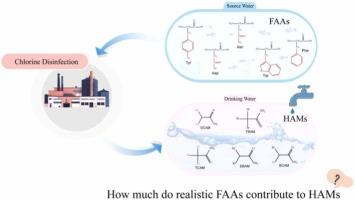Revealing the impact of side-chains in amino acids on the formation of haloacetamides during chlorination
IF 11.3
1区 环境科学与生态学
Q1 ENGINEERING, ENVIRONMENTAL
引用次数: 0
Abstract
Haloacetamides (HAMs) is a class of highly toxic emerging nitrogenous disinfection byproducts (N-DBPs) in drinking water, however the factors influencing the formation of HAMs by amino acids remain incompletely understood. Besides, a quantitative data regarding how many HAMs in chlorinated drinking water can attribute to amino acids in source water is lacking. To address this gap, HAMs formation during chlorination for 20 amino acids with different side-chains was analyzed. HAMs yield of 20 common amino acids during chlorination was 0.04-132 μg/mg-C. For different side-chains in amino acids, carboxyl group exhibited the highest HAM’s yield at 65.9 μg/mg-C, followed by aromatic rings (10.2 μg/mg-C), and containing nitrogen (10.1 μg/mg-C), respectively. In contrast, hydroxyl groups, sulfur-containing amino acids and those with only hydrogen and alkyl groups showed the lowest HAM’s yield (<1 μg/mg-C). HAM yields of basic and neutral amino acids were lower than that of acidic amino acids. HAM yields of nonpolar amino acids were lower than polar amino acids. The HAM formation potentials of amino acids in source water during chlorination were 14.8-5138 ng/L, with an average of 576 ng/L. Aspartic acid, asparagine, and histidine accounted for as much as 97% of the theoretical HAMs formation. The theoretical calculation found that amino acids in source water contribute about 3.2% of HAMs in chlorinated drinking water, which is close to that of lab-controlled experiments (4.3%), suggesting that the role of amino acids on HAMs in chlorinated drinking water is overvalued. Our study reveals the role of precursor’s side-chains on toxic DBP formation as well their potential contribution to drinking water DBPs.

揭示了在氯化过程中氨基酸侧链对卤代乙酰胺形成的影响
卤代乙酰胺(Haloacetamides, HAMs)是饮用水中一类剧毒的新兴含氮消毒副产物(N-DBPs),但影响氨基酸形成卤代乙酰胺的因素尚不完全清楚。此外,氯化饮用水中有多少氨基酸可归因于水源水中氨基酸的定量数据缺乏。为了解决这一差距,分析了20种不同侧链氨基酸在氯化过程中形成的HAMs。氯化过程中20种常见氨基酸的产率为0.04 ~ 132 μg/mg-C。对于不同侧链的氨基酸,羧基的HAM产率最高,为65.9 μg/mg-C,其次是芳香环(10.2 μg/mg-C)和含氮环(10.1 μg/mg-C)。羟基、含硫氨基酸和仅含氢和烷基的氨基酸的HAM产率最低(1 μg/mg-C)。碱性和中性氨基酸的火腿产量低于酸性氨基酸。非极性氨基酸的HAM产率低于极性氨基酸。氯化过程中水源水中氨基酸的HAM形成电位为14.8 ~ 5138 ng/L,平均为576 ng/L。天冬氨酸、天冬酰胺和组氨酸占了理论氨基酸形成的97%。理论计算发现,源水中氨基酸对氯化饮用水中氨基酸的贡献约为3.2%,与实验室对照实验(4.3%)接近,表明氨基酸对氯化饮用水中氨基酸的作用被高估。我们的研究揭示了前体侧链在毒性DBP形成中的作用以及它们对饮用水DBP的潜在贡献。
本文章由计算机程序翻译,如有差异,请以英文原文为准。
求助全文
约1分钟内获得全文
求助全文
来源期刊

Journal of Hazardous Materials
工程技术-工程:环境
CiteScore
25.40
自引率
5.90%
发文量
3059
审稿时长
58 days
期刊介绍:
The Journal of Hazardous Materials serves as a global platform for promoting cutting-edge research in the field of Environmental Science and Engineering. Our publication features a wide range of articles, including full-length research papers, review articles, and perspectives, with the aim of enhancing our understanding of the dangers and risks associated with various materials concerning public health and the environment. It is important to note that the term "environmental contaminants" refers specifically to substances that pose hazardous effects through contamination, while excluding those that do not have such impacts on the environment or human health. Moreover, we emphasize the distinction between wastes and hazardous materials in order to provide further clarity on the scope of the journal. We have a keen interest in exploring specific compounds and microbial agents that have adverse effects on the environment.
 求助内容:
求助内容: 应助结果提醒方式:
应助结果提醒方式:


